People Leadership and Culture: Impact of Leadership Style on Employees' Performance
VerifiedAdded on 2023/06/17
|12
|2880
|199
AI Summary
This report discusses the impact of leadership style on employees' performance and job satisfaction. It covers different leadership theories, including contingency and situational theory, and their impact on organizational culture. The report also includes examples of effective leadership styles and personal leadership style preferences.
Contribute Materials
Your contribution can guide someone’s learning journey. Share your
documents today.

1
PEOPLE LEADERSHIP
AND CULTURE
PEOPLE LEADERSHIP
AND CULTURE
Secure Best Marks with AI Grader
Need help grading? Try our AI Grader for instant feedback on your assignments.
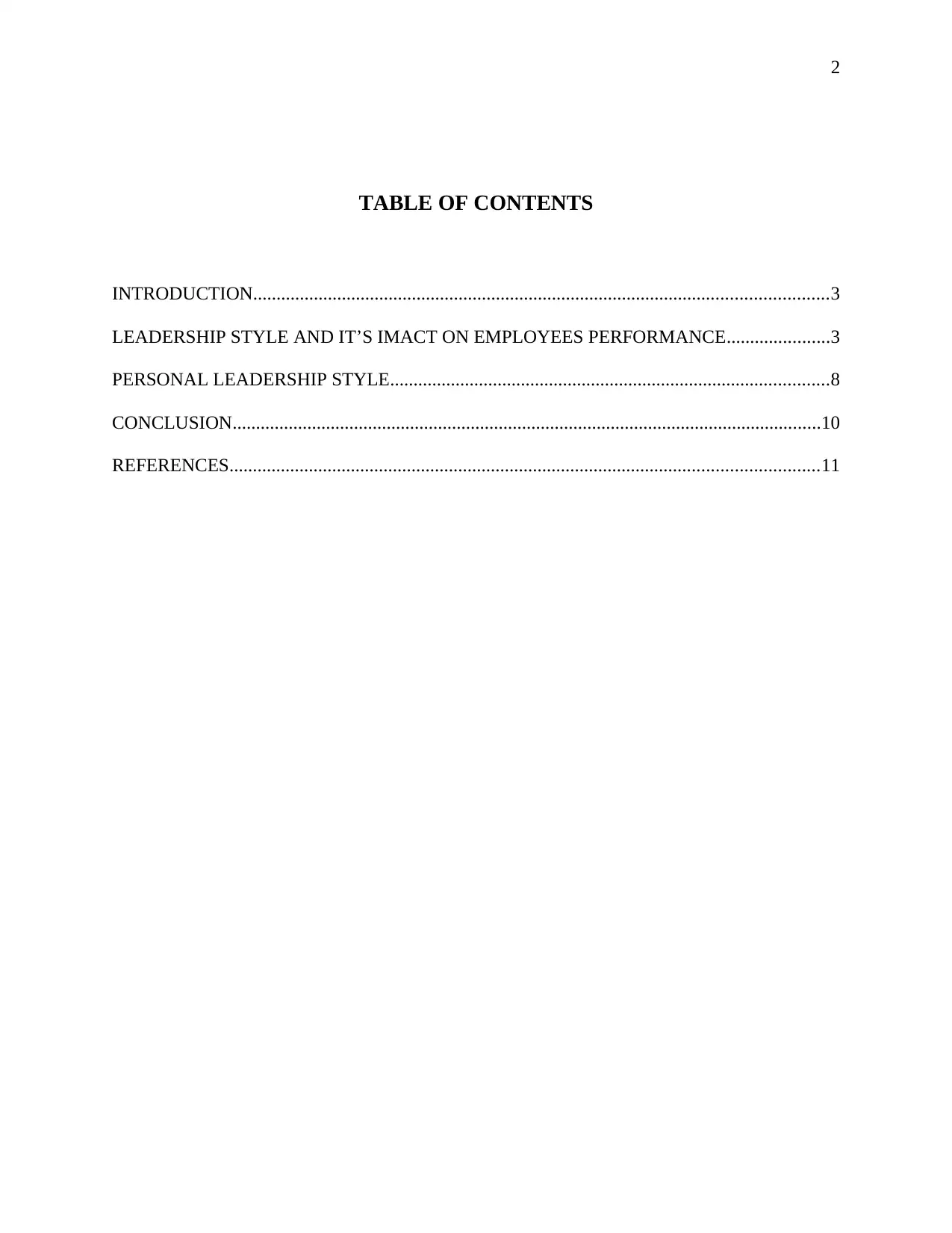
2
TABLE OF CONTENTS
INTRODUCTION...........................................................................................................................3
LEADERSHIP STYLE AND IT’S IMACT ON EMPLOYEES PERFORMANCE......................3
PERSONAL LEADERSHIP STYLE..............................................................................................8
CONCLUSION..............................................................................................................................10
REFERENCES..............................................................................................................................11
TABLE OF CONTENTS
INTRODUCTION...........................................................................................................................3
LEADERSHIP STYLE AND IT’S IMACT ON EMPLOYEES PERFORMANCE......................3
PERSONAL LEADERSHIP STYLE..............................................................................................8
CONCLUSION..............................................................................................................................10
REFERENCES..............................................................................................................................11
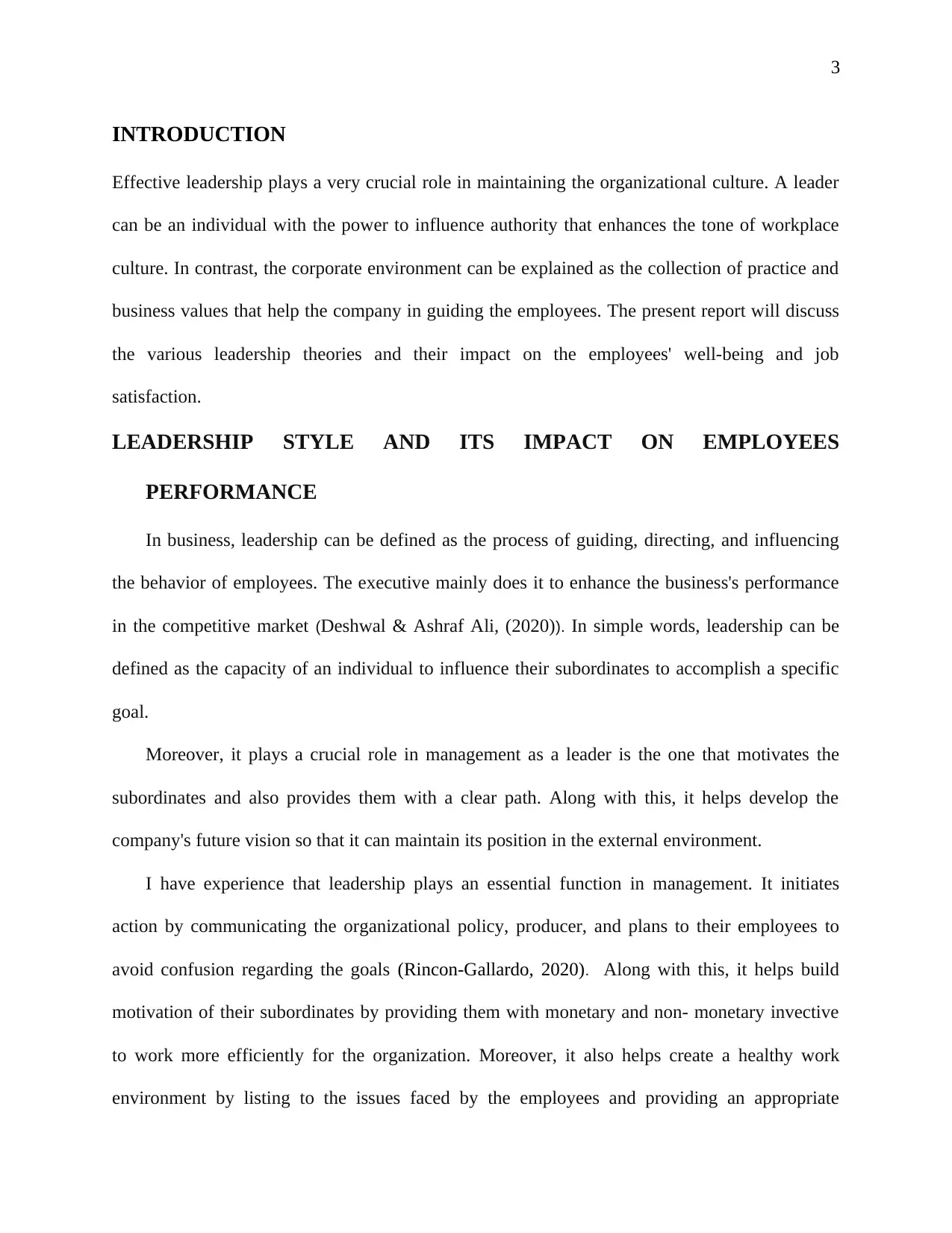
3
INTRODUCTION
Effective leadership plays a very crucial role in maintaining the organizational culture. A leader
can be an individual with the power to influence authority that enhances the tone of workplace
culture. In contrast, the corporate environment can be explained as the collection of practice and
business values that help the company in guiding the employees. The present report will discuss
the various leadership theories and their impact on the employees' well-being and job
satisfaction.
LEADERSHIP STYLE AND ITS IMPACT ON EMPLOYEES
PERFORMANCE
In business, leadership can be defined as the process of guiding, directing, and influencing
the behavior of employees. The executive mainly does it to enhance the business's performance
in the competitive market (Deshwal & Ashraf Ali, (2020)). In simple words, leadership can be
defined as the capacity of an individual to influence their subordinates to accomplish a specific
goal.
Moreover, it plays a crucial role in management as a leader is the one that motivates the
subordinates and also provides them with a clear path. Along with this, it helps develop the
company's future vision so that it can maintain its position in the external environment.
I have experience that leadership plays an essential function in management. It initiates
action by communicating the organizational policy, producer, and plans to their employees to
avoid confusion regarding the goals (Rincon-Gallardo, 2020). Along with this, it helps build
motivation of their subordinates by providing them with monetary and non- monetary invective
to work more efficiently for the organization. Moreover, it also helps create a healthy work
environment by listing to the issues faced by the employees and providing an appropriate
INTRODUCTION
Effective leadership plays a very crucial role in maintaining the organizational culture. A leader
can be an individual with the power to influence authority that enhances the tone of workplace
culture. In contrast, the corporate environment can be explained as the collection of practice and
business values that help the company in guiding the employees. The present report will discuss
the various leadership theories and their impact on the employees' well-being and job
satisfaction.
LEADERSHIP STYLE AND ITS IMPACT ON EMPLOYEES
PERFORMANCE
In business, leadership can be defined as the process of guiding, directing, and influencing
the behavior of employees. The executive mainly does it to enhance the business's performance
in the competitive market (Deshwal & Ashraf Ali, (2020)). In simple words, leadership can be
defined as the capacity of an individual to influence their subordinates to accomplish a specific
goal.
Moreover, it plays a crucial role in management as a leader is the one that motivates the
subordinates and also provides them with a clear path. Along with this, it helps develop the
company's future vision so that it can maintain its position in the external environment.
I have experience that leadership plays an essential function in management. It initiates
action by communicating the organizational policy, producer, and plans to their employees to
avoid confusion regarding the goals (Rincon-Gallardo, 2020). Along with this, it helps build
motivation of their subordinates by providing them with monetary and non- monetary invective
to work more efficiently for the organization. Moreover, it also helps create a healthy work
environment by listing to the issues faced by the employees and providing an appropriate
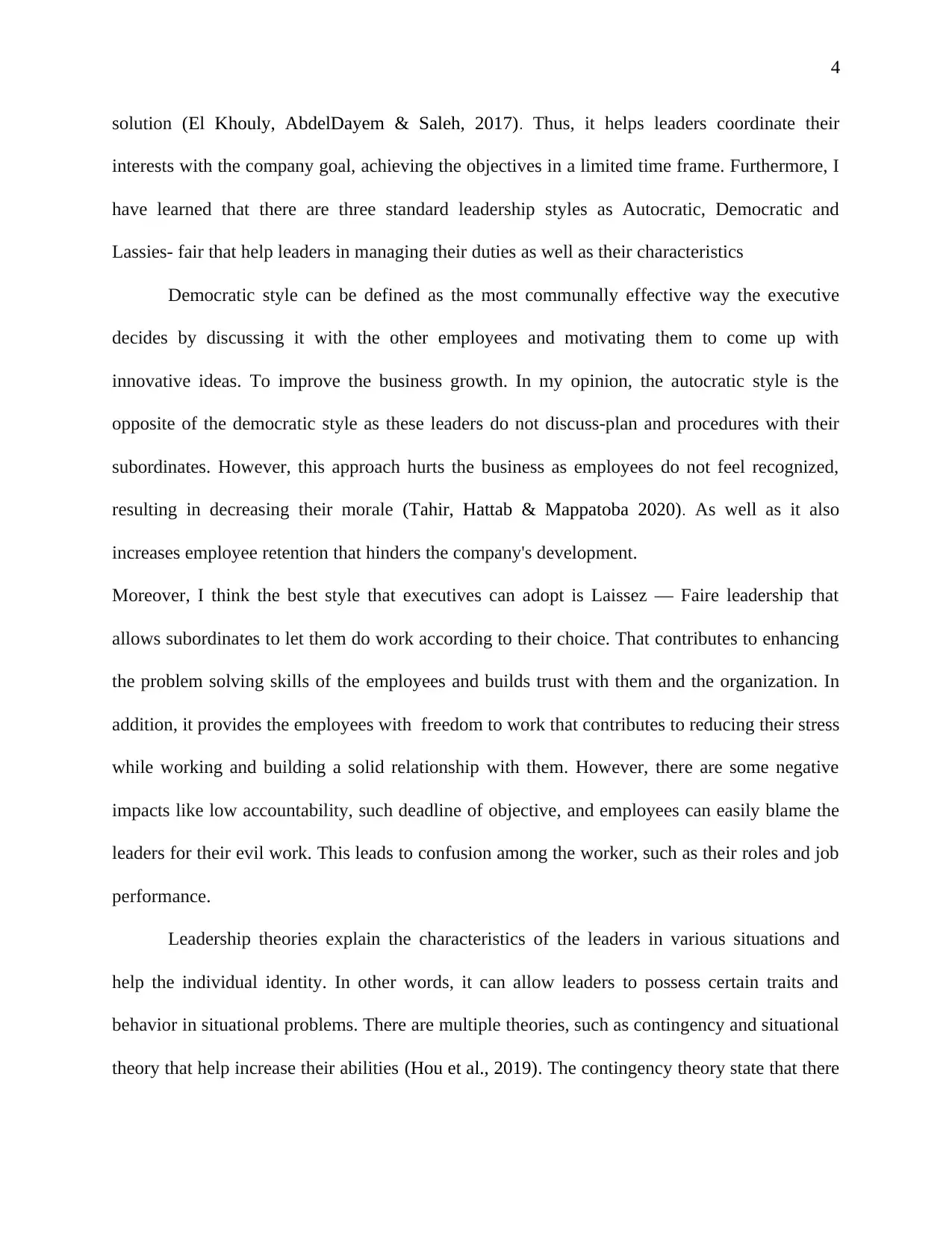
4
solution (El Khouly, AbdelDayem & Saleh, 2017). Thus, it helps leaders coordinate their
interests with the company goal, achieving the objectives in a limited time frame. Furthermore, I
have learned that there are three standard leadership styles as Autocratic, Democratic and
Lassies- fair that help leaders in managing their duties as well as their characteristics
Democratic style can be defined as the most communally effective way the executive
decides by discussing it with the other employees and motivating them to come up with
innovative ideas. To improve the business growth. In my opinion, the autocratic style is the
opposite of the democratic style as these leaders do not discuss-plan and procedures with their
subordinates. However, this approach hurts the business as employees do not feel recognized,
resulting in decreasing their morale (Tahir, Hattab & Mappatoba 2020). As well as it also
increases employee retention that hinders the company's development.
Moreover, I think the best style that executives can adopt is Laissez — Faire leadership that
allows subordinates to let them do work according to their choice. That contributes to enhancing
the problem solving skills of the employees and builds trust with them and the organization. In
addition, it provides the employees with freedom to work that contributes to reducing their stress
while working and building a solid relationship with them. However, there are some negative
impacts like low accountability, such deadline of objective, and employees can easily blame the
leaders for their evil work. This leads to confusion among the worker, such as their roles and job
performance.
Leadership theories explain the characteristics of the leaders in various situations and
help the individual identity. In other words, it can allow leaders to possess certain traits and
behavior in situational problems. There are multiple theories, such as contingency and situational
theory that help increase their abilities (Hou et al., 2019). The contingency theory state that there
solution (El Khouly, AbdelDayem & Saleh, 2017). Thus, it helps leaders coordinate their
interests with the company goal, achieving the objectives in a limited time frame. Furthermore, I
have learned that there are three standard leadership styles as Autocratic, Democratic and
Lassies- fair that help leaders in managing their duties as well as their characteristics
Democratic style can be defined as the most communally effective way the executive
decides by discussing it with the other employees and motivating them to come up with
innovative ideas. To improve the business growth. In my opinion, the autocratic style is the
opposite of the democratic style as these leaders do not discuss-plan and procedures with their
subordinates. However, this approach hurts the business as employees do not feel recognized,
resulting in decreasing their morale (Tahir, Hattab & Mappatoba 2020). As well as it also
increases employee retention that hinders the company's development.
Moreover, I think the best style that executives can adopt is Laissez — Faire leadership that
allows subordinates to let them do work according to their choice. That contributes to enhancing
the problem solving skills of the employees and builds trust with them and the organization. In
addition, it provides the employees with freedom to work that contributes to reducing their stress
while working and building a solid relationship with them. However, there are some negative
impacts like low accountability, such deadline of objective, and employees can easily blame the
leaders for their evil work. This leads to confusion among the worker, such as their roles and job
performance.
Leadership theories explain the characteristics of the leaders in various situations and
help the individual identity. In other words, it can allow leaders to possess certain traits and
behavior in situational problems. There are multiple theories, such as contingency and situational
theory that help increase their abilities (Hou et al., 2019). The contingency theory state that there
Secure Best Marks with AI Grader
Need help grading? Try our AI Grader for instant feedback on your assignments.
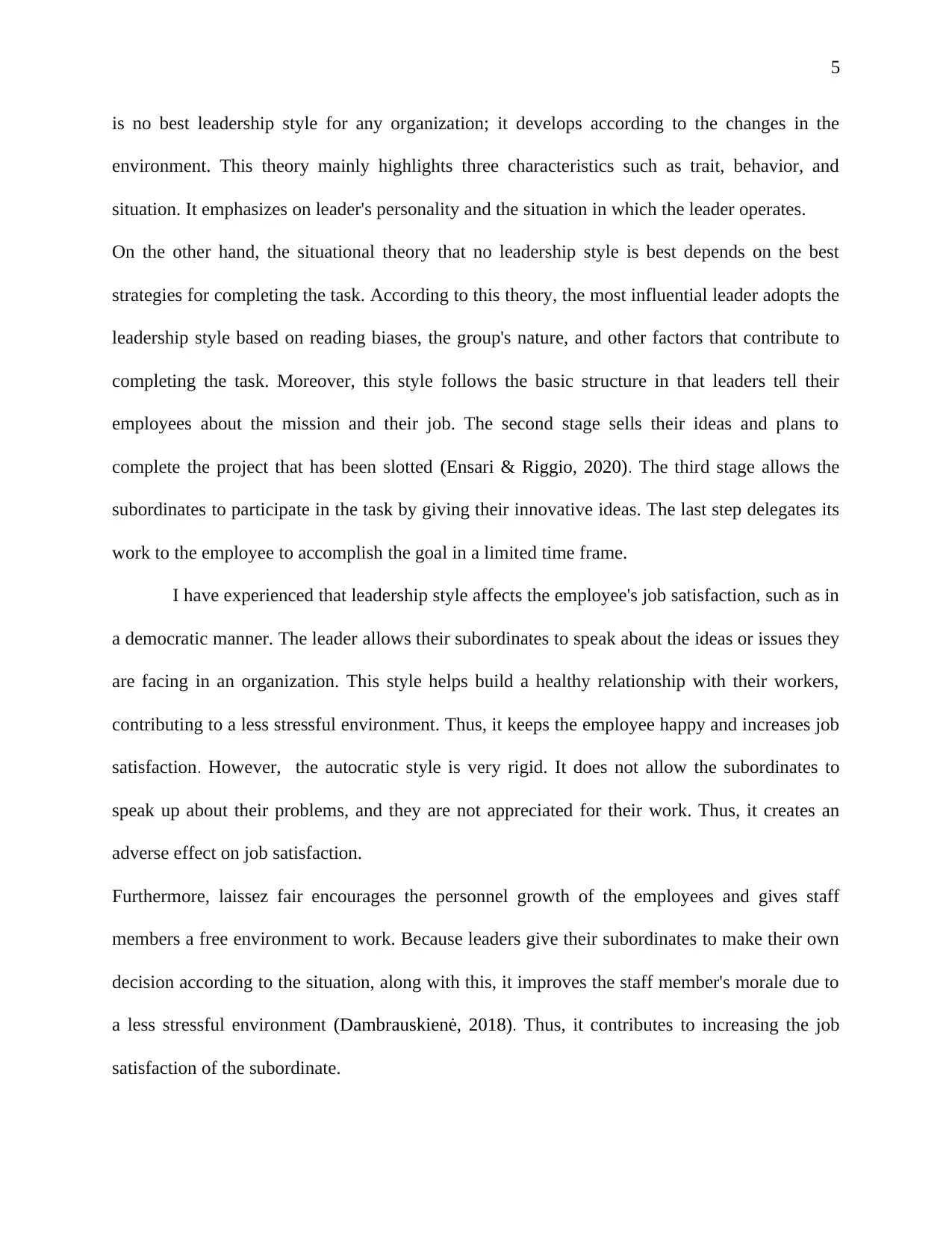
5
is no best leadership style for any organization; it develops according to the changes in the
environment. This theory mainly highlights three characteristics such as trait, behavior, and
situation. It emphasizes on leader's personality and the situation in which the leader operates.
On the other hand, the situational theory that no leadership style is best depends on the best
strategies for completing the task. According to this theory, the most influential leader adopts the
leadership style based on reading biases, the group's nature, and other factors that contribute to
completing the task. Moreover, this style follows the basic structure in that leaders tell their
employees about the mission and their job. The second stage sells their ideas and plans to
complete the project that has been slotted (Ensari & Riggio, 2020). The third stage allows the
subordinates to participate in the task by giving their innovative ideas. The last step delegates its
work to the employee to accomplish the goal in a limited time frame.
I have experienced that leadership style affects the employee's job satisfaction, such as in
a democratic manner. The leader allows their subordinates to speak about the ideas or issues they
are facing in an organization. This style helps build a healthy relationship with their workers,
contributing to a less stressful environment. Thus, it keeps the employee happy and increases job
satisfaction. However, the autocratic style is very rigid. It does not allow the subordinates to
speak up about their problems, and they are not appreciated for their work. Thus, it creates an
adverse effect on job satisfaction.
Furthermore, laissez fair encourages the personnel growth of the employees and gives staff
members a free environment to work. Because leaders give their subordinates to make their own
decision according to the situation, along with this, it improves the staff member's morale due to
a less stressful environment (Dambrauskienė, 2018). Thus, it contributes to increasing the job
satisfaction of the subordinate.
is no best leadership style for any organization; it develops according to the changes in the
environment. This theory mainly highlights three characteristics such as trait, behavior, and
situation. It emphasizes on leader's personality and the situation in which the leader operates.
On the other hand, the situational theory that no leadership style is best depends on the best
strategies for completing the task. According to this theory, the most influential leader adopts the
leadership style based on reading biases, the group's nature, and other factors that contribute to
completing the task. Moreover, this style follows the basic structure in that leaders tell their
employees about the mission and their job. The second stage sells their ideas and plans to
complete the project that has been slotted (Ensari & Riggio, 2020). The third stage allows the
subordinates to participate in the task by giving their innovative ideas. The last step delegates its
work to the employee to accomplish the goal in a limited time frame.
I have experienced that leadership style affects the employee's job satisfaction, such as in
a democratic manner. The leader allows their subordinates to speak about the ideas or issues they
are facing in an organization. This style helps build a healthy relationship with their workers,
contributing to a less stressful environment. Thus, it keeps the employee happy and increases job
satisfaction. However, the autocratic style is very rigid. It does not allow the subordinates to
speak up about their problems, and they are not appreciated for their work. Thus, it creates an
adverse effect on job satisfaction.
Furthermore, laissez fair encourages the personnel growth of the employees and gives staff
members a free environment to work. Because leaders give their subordinates to make their own
decision according to the situation, along with this, it improves the staff member's morale due to
a less stressful environment (Dambrauskienė, 2018). Thus, it contributes to increasing the job
satisfaction of the subordinate.
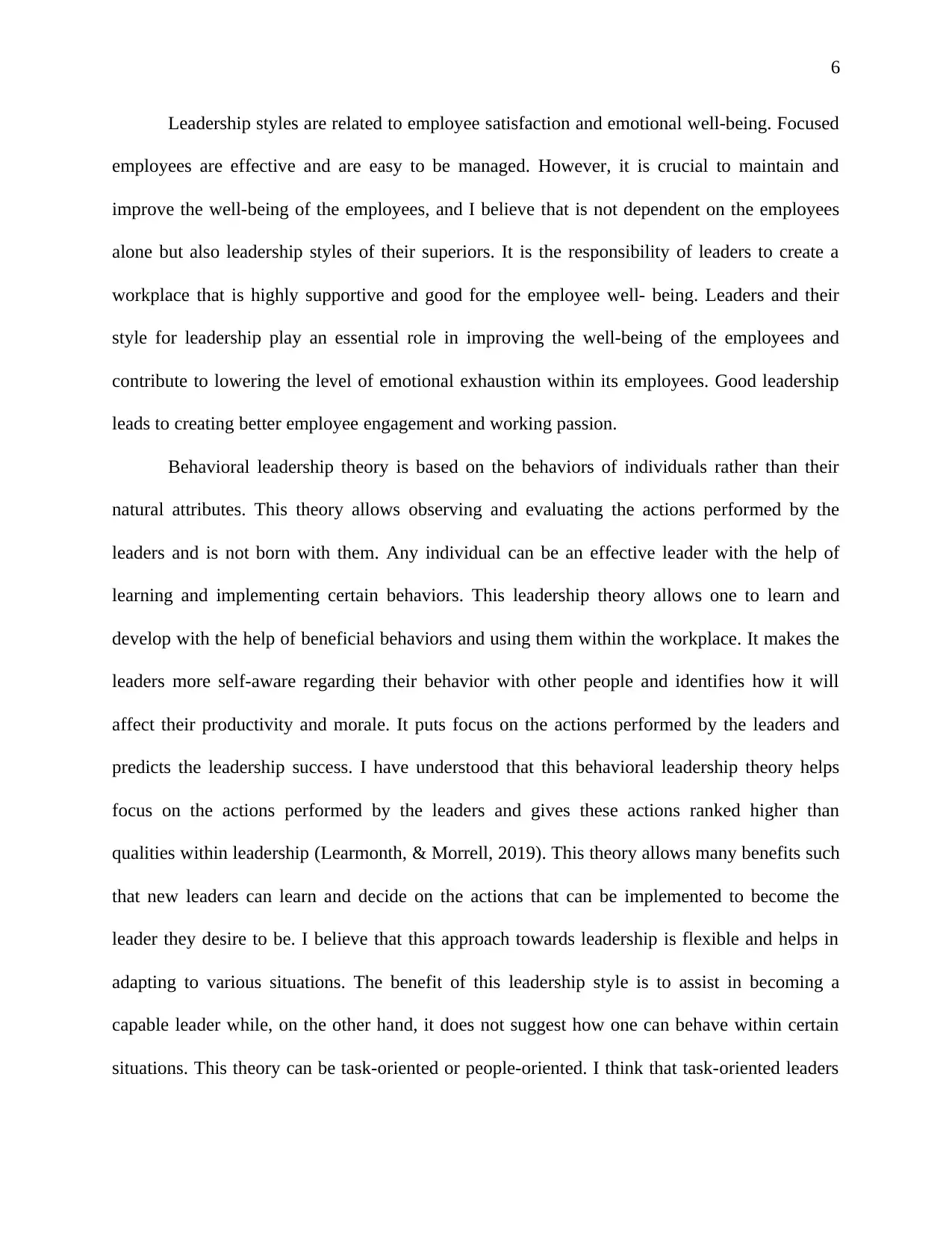
6
Leadership styles are related to employee satisfaction and emotional well-being. Focused
employees are effective and are easy to be managed. However, it is crucial to maintain and
improve the well-being of the employees, and I believe that is not dependent on the employees
alone but also leadership styles of their superiors. It is the responsibility of leaders to create a
workplace that is highly supportive and good for the employee well- being. Leaders and their
style for leadership play an essential role in improving the well-being of the employees and
contribute to lowering the level of emotional exhaustion within its employees. Good leadership
leads to creating better employee engagement and working passion.
Behavioral leadership theory is based on the behaviors of individuals rather than their
natural attributes. This theory allows observing and evaluating the actions performed by the
leaders and is not born with them. Any individual can be an effective leader with the help of
learning and implementing certain behaviors. This leadership theory allows one to learn and
develop with the help of beneficial behaviors and using them within the workplace. It makes the
leaders more self-aware regarding their behavior with other people and identifies how it will
affect their productivity and morale. It puts focus on the actions performed by the leaders and
predicts the leadership success. I have understood that this behavioral leadership theory helps
focus on the actions performed by the leaders and gives these actions ranked higher than
qualities within leadership (Learmonth, & Morrell, 2019). This theory allows many benefits such
that new leaders can learn and decide on the actions that can be implemented to become the
leader they desire to be. I believe that this approach towards leadership is flexible and helps in
adapting to various situations. The benefit of this leadership style is to assist in becoming a
capable leader while, on the other hand, it does not suggest how one can behave within certain
situations. This theory can be task-oriented or people-oriented. I think that task-oriented leaders
Leadership styles are related to employee satisfaction and emotional well-being. Focused
employees are effective and are easy to be managed. However, it is crucial to maintain and
improve the well-being of the employees, and I believe that is not dependent on the employees
alone but also leadership styles of their superiors. It is the responsibility of leaders to create a
workplace that is highly supportive and good for the employee well- being. Leaders and their
style for leadership play an essential role in improving the well-being of the employees and
contribute to lowering the level of emotional exhaustion within its employees. Good leadership
leads to creating better employee engagement and working passion.
Behavioral leadership theory is based on the behaviors of individuals rather than their
natural attributes. This theory allows observing and evaluating the actions performed by the
leaders and is not born with them. Any individual can be an effective leader with the help of
learning and implementing certain behaviors. This leadership theory allows one to learn and
develop with the help of beneficial behaviors and using them within the workplace. It makes the
leaders more self-aware regarding their behavior with other people and identifies how it will
affect their productivity and morale. It puts focus on the actions performed by the leaders and
predicts the leadership success. I have understood that this behavioral leadership theory helps
focus on the actions performed by the leaders and gives these actions ranked higher than
qualities within leadership (Learmonth, & Morrell, 2019). This theory allows many benefits such
that new leaders can learn and decide on the actions that can be implemented to become the
leader they desire to be. I believe that this approach towards leadership is flexible and helps in
adapting to various situations. The benefit of this leadership style is to assist in becoming a
capable leader while, on the other hand, it does not suggest how one can behave within certain
situations. This theory can be task-oriented or people-oriented. I think that task-oriented leaders
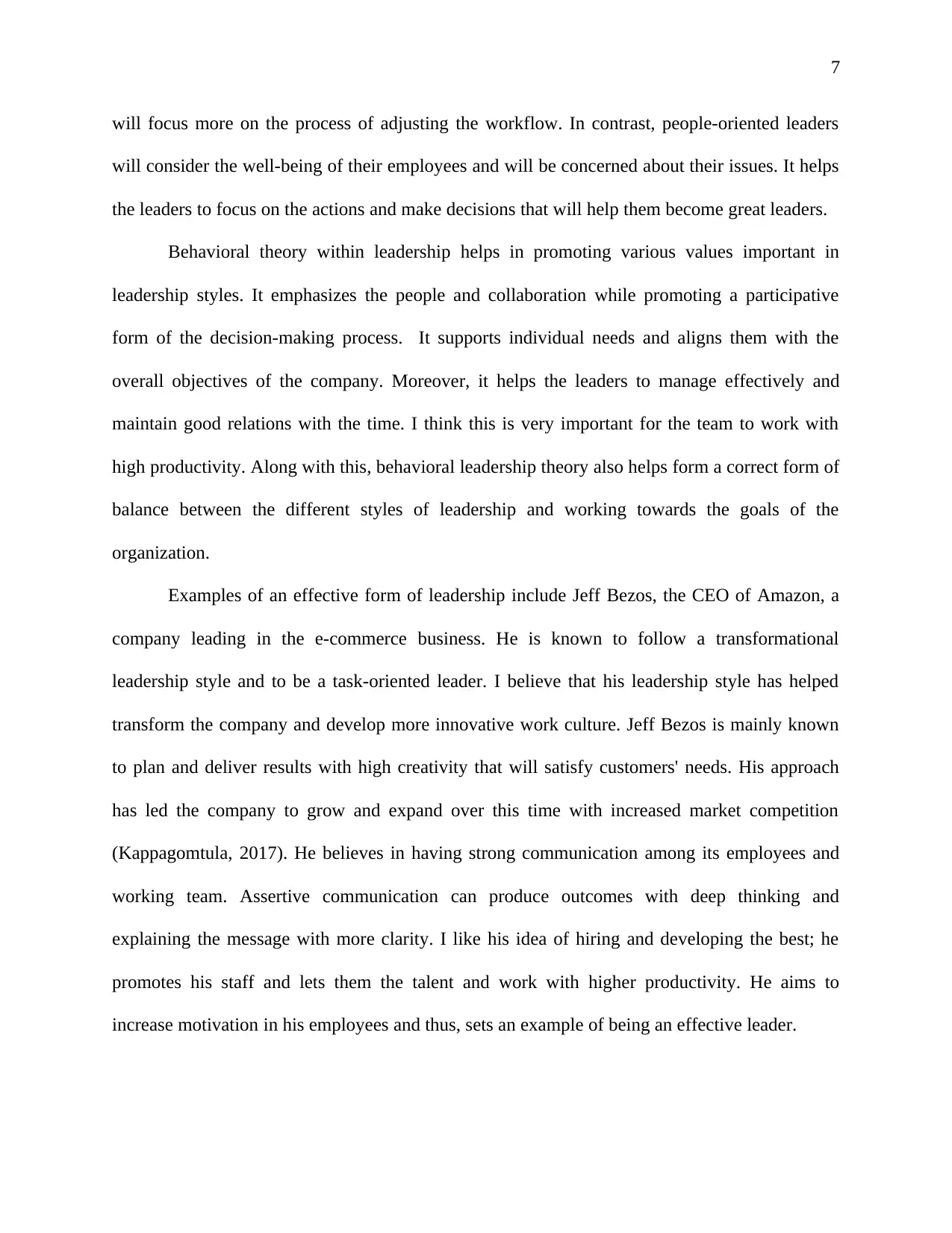
7
will focus more on the process of adjusting the workflow. In contrast, people-oriented leaders
will consider the well-being of their employees and will be concerned about their issues. It helps
the leaders to focus on the actions and make decisions that will help them become great leaders.
Behavioral theory within leadership helps in promoting various values important in
leadership styles. It emphasizes the people and collaboration while promoting a participative
form of the decision-making process. It supports individual needs and aligns them with the
overall objectives of the company. Moreover, it helps the leaders to manage effectively and
maintain good relations with the time. I think this is very important for the team to work with
high productivity. Along with this, behavioral leadership theory also helps form a correct form of
balance between the different styles of leadership and working towards the goals of the
organization.
Examples of an effective form of leadership include Jeff Bezos, the CEO of Amazon, a
company leading in the e-commerce business. He is known to follow a transformational
leadership style and to be a task-oriented leader. I believe that his leadership style has helped
transform the company and develop more innovative work culture. Jeff Bezos is mainly known
to plan and deliver results with high creativity that will satisfy customers' needs. His approach
has led the company to grow and expand over this time with increased market competition
(Kappagomtula, 2017). He believes in having strong communication among its employees and
working team. Assertive communication can produce outcomes with deep thinking and
explaining the message with more clarity. I like his idea of hiring and developing the best; he
promotes his staff and lets them the talent and work with higher productivity. He aims to
increase motivation in his employees and thus, sets an example of being an effective leader.
will focus more on the process of adjusting the workflow. In contrast, people-oriented leaders
will consider the well-being of their employees and will be concerned about their issues. It helps
the leaders to focus on the actions and make decisions that will help them become great leaders.
Behavioral theory within leadership helps in promoting various values important in
leadership styles. It emphasizes the people and collaboration while promoting a participative
form of the decision-making process. It supports individual needs and aligns them with the
overall objectives of the company. Moreover, it helps the leaders to manage effectively and
maintain good relations with the time. I think this is very important for the team to work with
high productivity. Along with this, behavioral leadership theory also helps form a correct form of
balance between the different styles of leadership and working towards the goals of the
organization.
Examples of an effective form of leadership include Jeff Bezos, the CEO of Amazon, a
company leading in the e-commerce business. He is known to follow a transformational
leadership style and to be a task-oriented leader. I believe that his leadership style has helped
transform the company and develop more innovative work culture. Jeff Bezos is mainly known
to plan and deliver results with high creativity that will satisfy customers' needs. His approach
has led the company to grow and expand over this time with increased market competition
(Kappagomtula, 2017). He believes in having strong communication among its employees and
working team. Assertive communication can produce outcomes with deep thinking and
explaining the message with more clarity. I like his idea of hiring and developing the best; he
promotes his staff and lets them the talent and work with higher productivity. He aims to
increase motivation in his employees and thus, sets an example of being an effective leader.
Paraphrase This Document
Need a fresh take? Get an instant paraphrase of this document with our AI Paraphraser
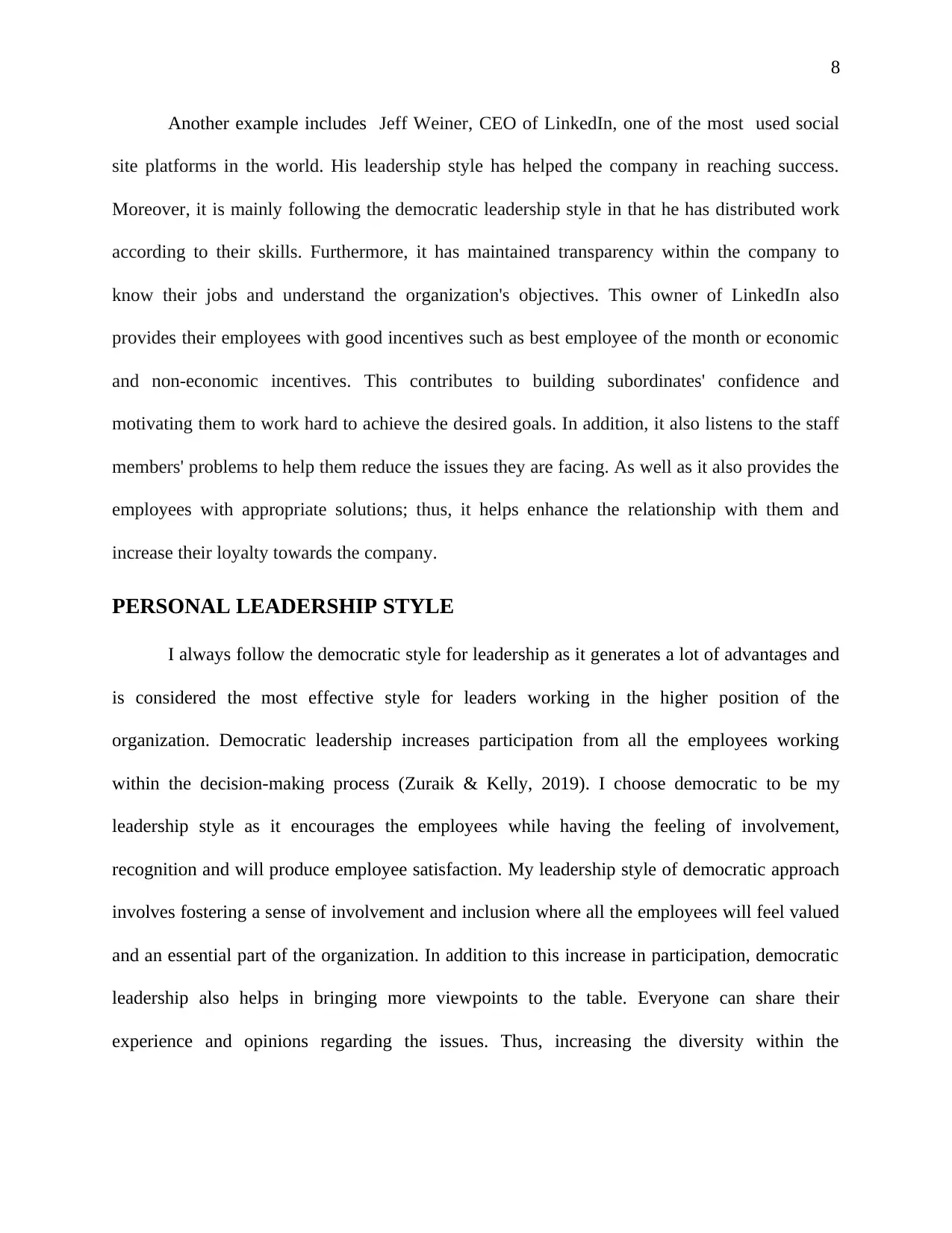
8
Another example includes Jeff Weiner, CEO of LinkedIn, one of the most used social
site platforms in the world. His leadership style has helped the company in reaching success.
Moreover, it is mainly following the democratic leadership style in that he has distributed work
according to their skills. Furthermore, it has maintained transparency within the company to
know their jobs and understand the organization's objectives. This owner of LinkedIn also
provides their employees with good incentives such as best employee of the month or economic
and non-economic incentives. This contributes to building subordinates' confidence and
motivating them to work hard to achieve the desired goals. In addition, it also listens to the staff
members' problems to help them reduce the issues they are facing. As well as it also provides the
employees with appropriate solutions; thus, it helps enhance the relationship with them and
increase their loyalty towards the company.
PERSONAL LEADERSHIP STYLE
I always follow the democratic style for leadership as it generates a lot of advantages and
is considered the most effective style for leaders working in the higher position of the
organization. Democratic leadership increases participation from all the employees working
within the decision-making process (Zuraik & Kelly, 2019). I choose democratic to be my
leadership style as it encourages the employees while having the feeling of involvement,
recognition and will produce employee satisfaction. My leadership style of democratic approach
involves fostering a sense of involvement and inclusion where all the employees will feel valued
and an essential part of the organization. In addition to this increase in participation, democratic
leadership also helps in bringing more viewpoints to the table. Everyone can share their
experience and opinions regarding the issues. Thus, increasing the diversity within the
Another example includes Jeff Weiner, CEO of LinkedIn, one of the most used social
site platforms in the world. His leadership style has helped the company in reaching success.
Moreover, it is mainly following the democratic leadership style in that he has distributed work
according to their skills. Furthermore, it has maintained transparency within the company to
know their jobs and understand the organization's objectives. This owner of LinkedIn also
provides their employees with good incentives such as best employee of the month or economic
and non-economic incentives. This contributes to building subordinates' confidence and
motivating them to work hard to achieve the desired goals. In addition, it also listens to the staff
members' problems to help them reduce the issues they are facing. As well as it also provides the
employees with appropriate solutions; thus, it helps enhance the relationship with them and
increase their loyalty towards the company.
PERSONAL LEADERSHIP STYLE
I always follow the democratic style for leadership as it generates a lot of advantages and
is considered the most effective style for leaders working in the higher position of the
organization. Democratic leadership increases participation from all the employees working
within the decision-making process (Zuraik & Kelly, 2019). I choose democratic to be my
leadership style as it encourages the employees while having the feeling of involvement,
recognition and will produce employee satisfaction. My leadership style of democratic approach
involves fostering a sense of involvement and inclusion where all the employees will feel valued
and an essential part of the organization. In addition to this increase in participation, democratic
leadership also helps in bringing more viewpoints to the table. Everyone can share their
experience and opinions regarding the issues. Thus, increasing the diversity within the
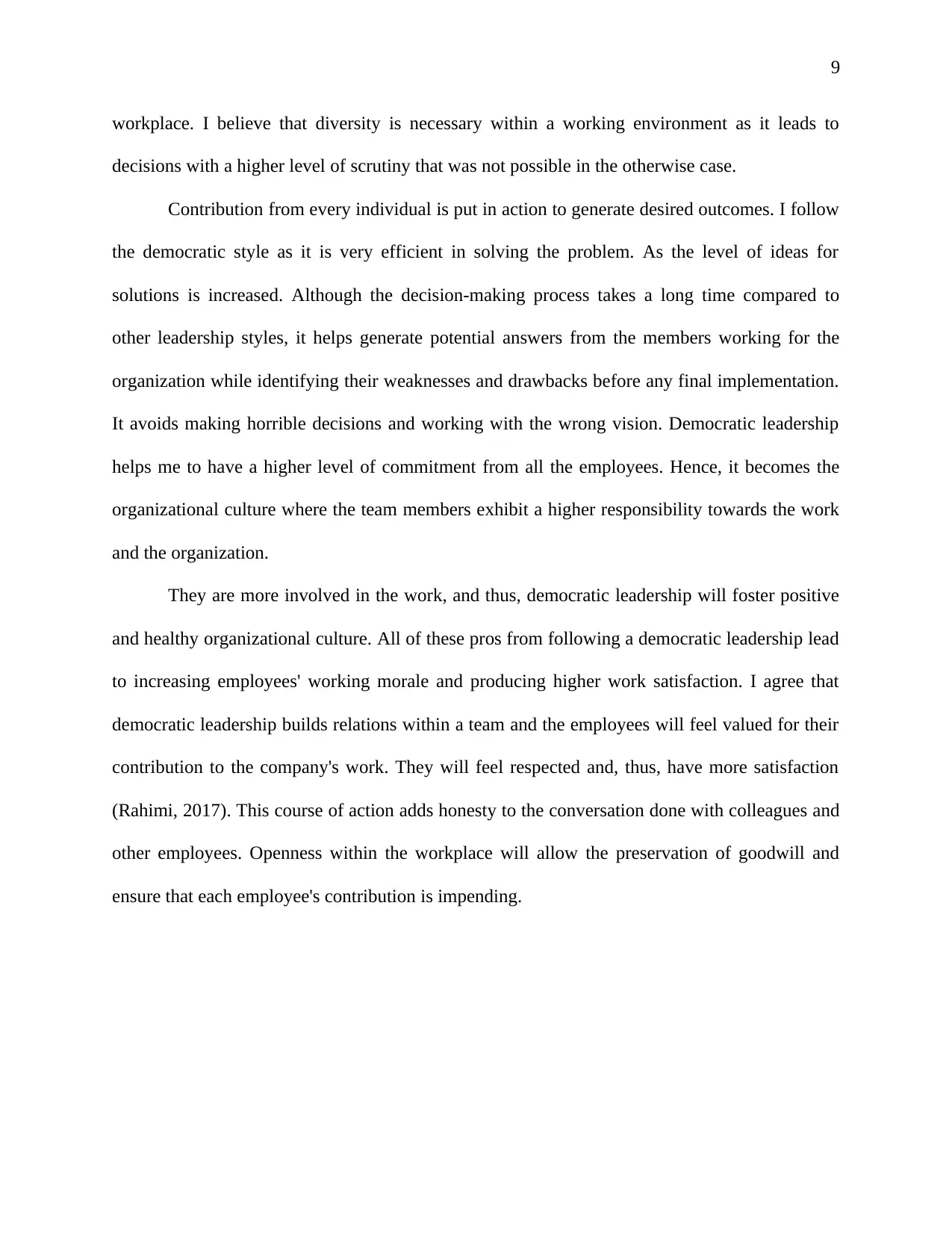
9
workplace. I believe that diversity is necessary within a working environment as it leads to
decisions with a higher level of scrutiny that was not possible in the otherwise case.
Contribution from every individual is put in action to generate desired outcomes. I follow
the democratic style as it is very efficient in solving the problem. As the level of ideas for
solutions is increased. Although the decision-making process takes a long time compared to
other leadership styles, it helps generate potential answers from the members working for the
organization while identifying their weaknesses and drawbacks before any final implementation.
It avoids making horrible decisions and working with the wrong vision. Democratic leadership
helps me to have a higher level of commitment from all the employees. Hence, it becomes the
organizational culture where the team members exhibit a higher responsibility towards the work
and the organization.
They are more involved in the work, and thus, democratic leadership will foster positive
and healthy organizational culture. All of these pros from following a democratic leadership lead
to increasing employees' working morale and producing higher work satisfaction. I agree that
democratic leadership builds relations within a team and the employees will feel valued for their
contribution to the company's work. They will feel respected and, thus, have more satisfaction
(Rahimi, 2017). This course of action adds honesty to the conversation done with colleagues and
other employees. Openness within the workplace will allow the preservation of goodwill and
ensure that each employee's contribution is impending.
workplace. I believe that diversity is necessary within a working environment as it leads to
decisions with a higher level of scrutiny that was not possible in the otherwise case.
Contribution from every individual is put in action to generate desired outcomes. I follow
the democratic style as it is very efficient in solving the problem. As the level of ideas for
solutions is increased. Although the decision-making process takes a long time compared to
other leadership styles, it helps generate potential answers from the members working for the
organization while identifying their weaknesses and drawbacks before any final implementation.
It avoids making horrible decisions and working with the wrong vision. Democratic leadership
helps me to have a higher level of commitment from all the employees. Hence, it becomes the
organizational culture where the team members exhibit a higher responsibility towards the work
and the organization.
They are more involved in the work, and thus, democratic leadership will foster positive
and healthy organizational culture. All of these pros from following a democratic leadership lead
to increasing employees' working morale and producing higher work satisfaction. I agree that
democratic leadership builds relations within a team and the employees will feel valued for their
contribution to the company's work. They will feel respected and, thus, have more satisfaction
(Rahimi, 2017). This course of action adds honesty to the conversation done with colleagues and
other employees. Openness within the workplace will allow the preservation of goodwill and
ensure that each employee's contribution is impending.
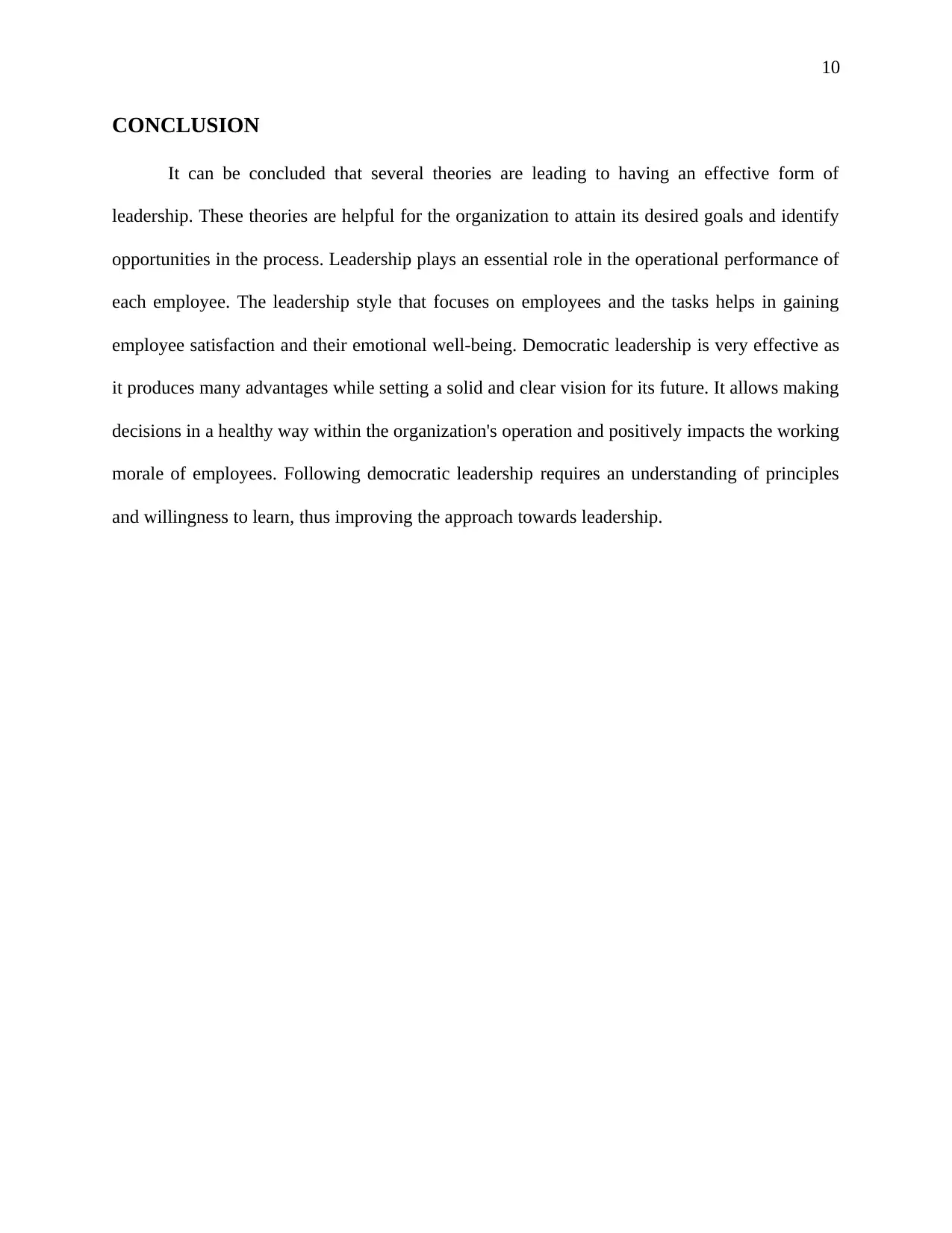
10
CONCLUSION
It can be concluded that several theories are leading to having an effective form of
leadership. These theories are helpful for the organization to attain its desired goals and identify
opportunities in the process. Leadership plays an essential role in the operational performance of
each employee. The leadership style that focuses on employees and the tasks helps in gaining
employee satisfaction and their emotional well-being. Democratic leadership is very effective as
it produces many advantages while setting a solid and clear vision for its future. It allows making
decisions in a healthy way within the organization's operation and positively impacts the working
morale of employees. Following democratic leadership requires an understanding of principles
and willingness to learn, thus improving the approach towards leadership.
CONCLUSION
It can be concluded that several theories are leading to having an effective form of
leadership. These theories are helpful for the organization to attain its desired goals and identify
opportunities in the process. Leadership plays an essential role in the operational performance of
each employee. The leadership style that focuses on employees and the tasks helps in gaining
employee satisfaction and their emotional well-being. Democratic leadership is very effective as
it produces many advantages while setting a solid and clear vision for its future. It allows making
decisions in a healthy way within the organization's operation and positively impacts the working
morale of employees. Following democratic leadership requires an understanding of principles
and willingness to learn, thus improving the approach towards leadership.
Secure Best Marks with AI Grader
Need help grading? Try our AI Grader for instant feedback on your assignments.

11
REFERENCES
Books and Journals
Dambrauskienė, D. (2018). Challenges for the distributed leadership development of education
institutions in a hierarchical national culture. Organizacijų vadyba: sisteminiai tyrimai,
(79), 37-53.
El Khouly, S., AbdelDayem, M., & Saleh, I. (2017). The impact of leadership styles on strategy
implementation in the Egyptian pharmaceutical field. In Competition Forum (Vol. 15,
No. 1, pp. 240-246). American Society for Competitiveness.
Ensari, N., & Riggio, R. E. (2020). Exclusion of Inclusion in Leadership Theories. In Inclusive
Leadership (pp. 25-38). Routledge.
Hou, B et al., (2019). Paternalistic leadership and innovation: the moderating effect of
environmental dynamism. European Journal of Innovation Management.
Kappagomtula, C. L. (2017). Overcoming challenges in leadership roles–managing large projects
with multi or cross culture teams. European Business Review.
Learmonth, M., & Morrell, K. (2019). Critical perspectives on leadership: The language of
corporate power. Routledge.
Rahimi, R. (2017). Customer relationship management (people, process and technology) and
organisational culture in hotels: Which traits matter?. International Journal of
Contemporary Hospitality Management.
Rincon-Gallardo, S. (2020). Leading school networks to liberate learning: three leadership
roles. School Leadership & Management, 40(2-3), 146-162.
REFERENCES
Books and Journals
Dambrauskienė, D. (2018). Challenges for the distributed leadership development of education
institutions in a hierarchical national culture. Organizacijų vadyba: sisteminiai tyrimai,
(79), 37-53.
El Khouly, S., AbdelDayem, M., & Saleh, I. (2017). The impact of leadership styles on strategy
implementation in the Egyptian pharmaceutical field. In Competition Forum (Vol. 15,
No. 1, pp. 240-246). American Society for Competitiveness.
Ensari, N., & Riggio, R. E. (2020). Exclusion of Inclusion in Leadership Theories. In Inclusive
Leadership (pp. 25-38). Routledge.
Hou, B et al., (2019). Paternalistic leadership and innovation: the moderating effect of
environmental dynamism. European Journal of Innovation Management.
Kappagomtula, C. L. (2017). Overcoming challenges in leadership roles–managing large projects
with multi or cross culture teams. European Business Review.
Learmonth, M., & Morrell, K. (2019). Critical perspectives on leadership: The language of
corporate power. Routledge.
Rahimi, R. (2017). Customer relationship management (people, process and technology) and
organisational culture in hotels: Which traits matter?. International Journal of
Contemporary Hospitality Management.
Rincon-Gallardo, S. (2020). Leading school networks to liberate learning: three leadership
roles. School Leadership & Management, 40(2-3), 146-162.

12
Tahir, D., Hattab, S., & Mappatoba, M. (2020). Building public trust through service quality
based on leadership and organizational culture. Journal of Southwest Jiaotong
University, 55(3).
Zuraik, A., & Kelly, L. (2019). The role of CEO transformational leadership and innovation
climate in exploration and exploitation. European Journal of Innovation Management.
Online
leadership theories., 2021. [Online]. Available through <https://www.wgu.edu/blog/leadership-
theories-styles2004.html#:~:text=Leadership%20theories%20are%20the
%20explanations,ethics%20and%20high%20moral%20standards >.
Tahir, D., Hattab, S., & Mappatoba, M. (2020). Building public trust through service quality
based on leadership and organizational culture. Journal of Southwest Jiaotong
University, 55(3).
Zuraik, A., & Kelly, L. (2019). The role of CEO transformational leadership and innovation
climate in exploration and exploitation. European Journal of Innovation Management.
Online
leadership theories., 2021. [Online]. Available through <https://www.wgu.edu/blog/leadership-
theories-styles2004.html#:~:text=Leadership%20theories%20are%20the
%20explanations,ethics%20and%20high%20moral%20standards >.
1 out of 12
Related Documents
Your All-in-One AI-Powered Toolkit for Academic Success.
+13062052269
info@desklib.com
Available 24*7 on WhatsApp / Email
![[object Object]](/_next/static/media/star-bottom.7253800d.svg)
Unlock your academic potential
© 2024 | Zucol Services PVT LTD | All rights reserved.





